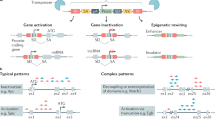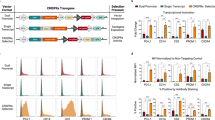Abstract
Over the past decade, ‘RNA interference’ has emerged as a natural mechanism of silencing of gene expression. This ancient cellular antiviral response can be manipulated to provide an effective research tool to knock down the level of expression of selected target genes, providing a very powerful new method for the analysis of cell signalling pathways. Systematic silencing of genes on a genome-wide scale using large rationally designed libraries targeting many thousands of genes provides a novel functional genomics approach to the investigation of many aspects of mammalian cell behaviour, including oncogenic transformation. Here, the different approaches taken to use RNA interference libraries to study the cancer phenotype will be considered, including both selective and high throughput screens and the use of both vector-based and synthetic oligonucleotide-based methods for inducing RNA interference. The advantages and drawbacks of the competing methodologies will be discussed. RNA interference library technology holds great promise for enabling somatic cell genetics in tissue culture systems. Whether it can provide significant new insights into cancer will be its greatest challenge.
This is a preview of subscription content, access via your institution
Access options
Subscribe to this journal
Receive 50 print issues and online access
$259.00 per year
only $5.18 per issue
Buy this article
- Purchase on Springer Link
- Instant access to full article PDF
Prices may be subject to local taxes which are calculated during checkout

Similar content being viewed by others
References
Abbas-Terki T, Blanco-Bose W, Deglon N, Pralong W and Aebischer P . (2002). Hum. Gene. Ther., 13, 2197–2201.
Arts GJ, Langemeijer E, Tissingh R, Ma L, Pavliska H, Dokic K, Dooijes R, Mesic E, Clasen R, Michiels F, van der Schueren J, Lambrecht M, Herman S, Brys R, Thys K, Hoffmann M, Tomme P and van Es H . (2003). Genome. Res., 13, 2325–2332.
Aza-Blanc P, Cooper CL, Wagner K, Batalov S, Deveraux QL and Cooke MP . (2003). Mol. Cell, 12, 627–637.
Berns K, Hijmans EM, Mullenders J, Brummelkamp TR, Velds A, Heinerikx M, Kerkhoven RM, Madiredjo M, Nijkamp W, Weigelt B, Agami R, Ge W, Cavet G, Linsley PS, Beijersbergen RL and Bernards R . (2004). Nature, 428, 431–437.
Bridge AJ, Pebernard S, Ducraux A, Nicoulaz AL and Iggo R . (2003). Nat. Genet., 34, 263–264.
Brummelkamp TR and Bernards R . (2003). Nat. Rev. Cancer, 3, 781–789.
Brummelkamp TR, Bernards R and Agami R . (2002a). Cancer Cell, 2, 243–247.
Brummelkamp TR, Bernards R and Agami R . (2002b). Science, 296, 550–553.
Brummelkamp TR, Nijman SM, Dirac AM and Bernards R . (2003). Nature, 424, 797–801.
Chen Y, Stamatoyannopoulos G and Song CZ . (2003). Cancer Res., 63, 4801–4804.
Chi JT, Chang HY, Wang NN, Chang DS, Dunphy N and Brown PO . (2003). Proc. Natl. Acad. Sci. USA, 100, 6343–6346.
Cui W, Ning J, Naik UP and Duncan MK . (2004). Comput. Methods Prog. Biomed., 75, 67–73.
Czauderna F, Santel A, Hinz M, Fechtner M, Durieux B, Fisch G, Leenders F, Arnold W, Giese K, Klippel A and Kaufmann J . (2003). Nucleic Acids Res., 31, e127.
Denli AM and Hannon GJ . (2003). Trends Biochem. Sci., 28, 196–201.
Dirac AM and Bernards R . (2003). J. Biol. Chem., 278, 11731–11734.
Downward J . (2004). BMJ, 328, 1245–1248.
Dykxhoorn DM, Novina CD and Sharp PA . (2003). Nat. Rev. Mol. Cell. Biol., 4, 457–467.
Elbashir SM, Harborth J, Lendeckel W, Yalcin A, Weber K and Tuschl T . (2001). Nature, 411, 494–498.
Elbashir SM, Harborth J, Weber K and Tuschl T . (2002). Methods, 26, 199–213.
Gupta S, Schoer RA, Egan JE, Hannon GJ and Mittal V . (2004). Proc. Natl. Acad. Sci. USA, 101, 1927–1932.
Hannon GJ . (2002). Nature, 418, 244–251.
He L and Hannon GJ . (2004). Nat. Rev. Genet., 5, 522–531.
Jackson AL, Bartz SR, Schelter J, Kobayashi SV, Burchard J, Mao M, Li B, Cavet G and Linsley PS . (2003). Nat. Biotechnol., 21, 635–637.
Khvorova A, Reynolds A and Jayasena SD . (2003). Cell, 115, 209–216.
Kumar R, Conklin DS and Mittal V . (2003). Genome Res., 13, 2333–2340.
Paddison PJ, Caudy AA, Bernstein E, Hannon GJ and Conklin DS . (2002a). Genes Dev., 16, 948–958.
Paddison PJ, Caudy AA and Hannon GJ . (2002b). Proc. Natl. Acad. Sci. USA, 99, 1443–1448.
Paddison PJ, Silva JM, Conklin DS, Schlabach M, Li M, Aruleba S, Balija V, O’Shaughnessy A, Gnoj L, Scobie K, Chang K, Westbrook T, Cleary M, Sachidanandam R, McCombie WR, Elledge SJ and Hannon GJ . (2004). Nature, 428, 427–431.
Reynolds A, Leake D, Boese Q, Scaringe S, Marshall WS and Khvorova A . (2004). Nat. Biotechnol., 22, 326–330.
Rubinson DA, Dillon CP, Kwiatkowski AV, Sievers C, Yang L, Kopinja J, Rooney DL, Ihrig MM, McManus MT, Gertler FB, Scott ML and Van Parijs L . (2003). Nat. Genet., 33, 401–406.
Schwarz DS, Hutvagner G, Du T, Xu Z, Aronin N and Zamore PD . (2003). Cell, 115, 199–208.
Silva JM, Mizuno H, Brady A, Lucito R and Hannon GJ . (2004). Proc. Natl. Acad. Sci. USA, 101, 6548–6552.
van de Wetering M, Oving I, Muncan V, Pon Fong MT, Brantjes H, van Leenen D, Holstege FC, Brummelkamp TR, Agami R and Clevers H . (2003). EMBO Rep., 4, 609–615.
Wang L and Mu FY . (2004). Bioinformatics, 20, 1818–1820.
Weinstein IB . (2002). Science, 297, 63–64.
Wiznerowicz M and Trono D . (2003). J. Virol., 77, 8957–8961.
Zhao LJ, Jian H and Zhu H . (2003). Gene., 316, 137–141.
Author information
Authors and Affiliations
Corresponding author
Rights and permissions
About this article
Cite this article
Downward, J. Use of RNA interference libraries to investigate oncogenic signalling in mammalian cells. Oncogene 23, 8376–8383 (2004). https://doi.org/10.1038/sj.onc.1208073
Published:
Issue Date:
DOI: https://doi.org/10.1038/sj.onc.1208073
Keywords
This article is cited by
-
Functional genomics identifies new synergistic therapies for retinoblastoma
Oncogene (2020)
-
Targeting the PI3K/AKT/mTOR signaling pathway in glioblastoma: novel therapeutic agents and advances in understanding
Tumor Biology (2013)
-
Critical role for transcriptional repressor Snail2 in transformation by oncogenic RAS in colorectal carcinoma cells
Oncogene (2010)
-
Repression of SHP-1 expression by p53 leads to trkA tyrosine phosphorylation and suppression of breast cancer cell proliferation
Oncogene (2009)
-
Single cell cytometry of protein function in RNAi treated cells and in native populations
BMC Cell Biology (2008)



